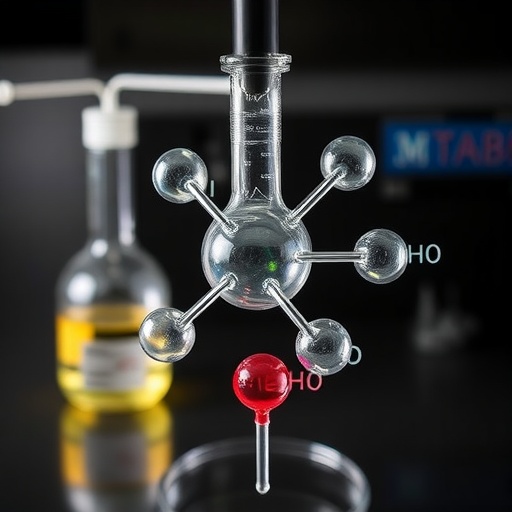In a groundbreaking advancement poised to revolutionize chemical manufacturing, researchers at Nagoya University have engineered a novel catalyst system that facilitates the oxidation of alcohols at unprecedentedly low temperatures. This innovation not only dramatically reduces the energy demands traditionally associated with these reactions but also eliminates the reliance on hazardous heavy metals and costly precious metals. The development marks a significant stride toward safer, cleaner, and more sustainable chemical processes, addressing long-standing challenges in industrial oxidation reactions.
Oxidation of alcohols to aldehydes, ketones, and carboxylic acids is a cornerstone reaction in organic synthesis, underpinning the production of a myriad of consumer products ranging from pharmaceuticals and fragrances to plastics and specialty chemicals. Conventional industrial methods often employ transition metals such as chromium or manganese as catalysts, which, despite their efficacy, pose environmental and health concerns due to their toxicity and difficulty in waste management. The high temperatures usually required to drive these oxidation processes further limit the synthesis of thermally sensitive molecules, constraining the scope and efficiency of chemical manufacturing.
The pursuit of greener alternatives catalyzed researchers led by Professor Kazuaki Ishihara at Nagoya University to harness iodine—a widely abundant, less toxic element—to replace these problematic metals in catalytic oxidation. In 2009, the team introduced an iodine-oxone catalyst system, capitalizing on 2-iodoxybenzenesulfonic acid (IBS) as the catalytic agent, which could convert alcohols sustainably into valuable oxidation products. Although this system offered a significant environmental leap by obviating heavy metals, it necessitated a reaction temperature of 70°C to achieve effective catalyst activation and conversion rates, undermining some green chemistry principles due to its energy intensity.
The latest breakthrough meticulously addresses this limitation by innovating a pre-activated form of the IBS catalyst combined with an auxiliary compound, tetrabutylammonium hydrogen sulfate, which effectively enhances the solubility and dispersion of oxone, the oxidizing agent employed. Oxone’s known poor solubility in organic solvents had previously hindered efficient interaction with the catalyst, resulting in sluggish activation kinetics that forced the requirement of elevated temperatures. By facilitating better molecular-level mixing and employing a pre-activated catalyst, the team has succeeded in initiating the oxidation process at a substantially reduced temperature of 30°C, representing a dramatic step forward in energy conservation.
This low-temperature operation is particularly transformative for the synthesis of heat-sensitive compounds, which are prevalent in the pharmaceutical and specialty chemicals sectors. High temperatures in traditional oxidation reactions often degrade these sensitive molecules, limiting the achievable molecular complexity and functionality. The ability to conduct effective oxidation at mild temperatures broadens the horizon for molecular architectures accessible through green catalysis, thereby accelerating innovation in drug development and advanced materials.
An additional remarkable feature of this catalytic system is its aptitude for one-pot synthesis, where multiple synthetic steps occur sequentially within a single reaction vessel without intermediate purification. This approach not only curtails material and energy waste but also shortens production timelines and reduces costs. The oxidation products swiftly serve as substrates for subsequent reactions seamlessly, amplifying overall process efficiency and scalability, which are critical parameters for industrial adoption.
Technical investigations delved deep into the mechanistic bottlenecks obstructing efficient low-temperature catalysis. Using sophisticated nuclear magnetic resonance (NMR) spectroscopy, the researchers tracked the conversion trajectory of pre-IBS to its active IBS(III) form, revealing that the sluggish catalyst activation—rather than the alcohol oxidation itself—was the rate-limiting step. This insight redirected the research focus toward circumventing this kinetic hurdle, culminating in the strategic pre-activation of the catalyst prior to its deployment in the reaction milieu.
Professor Ishihara underscored the significance of these findings, emphasizing the dual benefits of enhanced safety and sustainability: by decreasing temperature requirements, the method reduces energy consumption, thereby lowering the carbon footprint of oxidation processes. Concurrently, the replacement of toxic metals with iodine not only simplifies waste handling but also aligns with global regulatory trends increasingly favoring environmentally benign chemical practices.
Japan, notable as the world’s second-largest iodine producer, stands to gain economically and environmentally from this innovation. The domestic chemical industry can leverage the abundant iodine resource to scale up these catalytic systems, potentially setting new benchmarks in industrial green chemistry practices. This development resonates strongly with international efforts aimed at fostering circular economy principles and sustainable resource utilization in chemical manufacturing.
Looking ahead, the research team envisions refining the system further by substituting auxiliary reagents with greener alternatives and establishing protocols for catalyst recycling. Catalyst recyclability remains a pivotal challenge in commercial catalysis, and improvements in this domain would magnify the process’s environmental and cost advantages, solidifying its viability for widespread industrial application.
The findings published in Green Chemistry articulate not only a methodological advancement but also a conceptual shift towards rethinking catalytic design principles. By integrating molecular-level insights with practical process engineering, this study exemplifies how fundamental research can directly impact industry, environmental policy, and consumer product integrity.
In summary, Nagoya University’s innovative iodine-based catalytic system represents a paradigm shift in alcohol oxidation chemistry. By elegantly combining pre-activated catalysis with enhanced reactant mixing, the team has charted a sustainable pathway that balances chemical efficiency, environmental responsibility, and economic pragmatism. This technology exemplifies the future of green chemistry—where high performance and low environmental impact coexist harmoniously, inspiring further research and industrial transformation.
Subject of Research: Green catalytic oxidation of alcohols using iodine-based systems at low temperatures
Article Title: The low-temperature selective oxidation of alcohols and a one-pot oxidative esterification using an IBS(III/V)/oxone catalysis
News Publication Date: 7-Jul-2025
Web References:
References:
Ishihara, K., Uyanik, M., & Kondo, R. (2025). The low-temperature selective oxidation of alcohols and a one-pot oxidative esterification using an IBS(III/V)/oxone catalysis. Green Chemistry. DOI: 10.1039/d5gc01737h
Image Credits: Laboratory of Catalysis in Organic Synthesis, Nagoya University
Keywords
Oxidation catalysts, Oxidation, Catalysis, Esters, Aldehydes, Green chemistry




